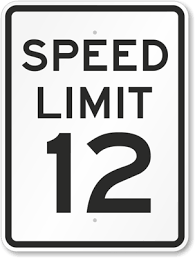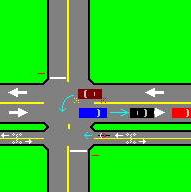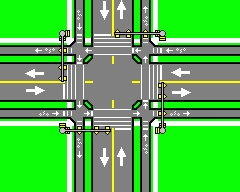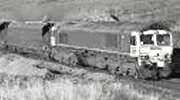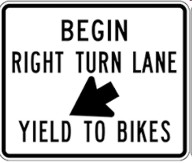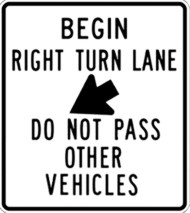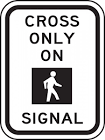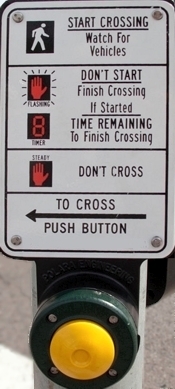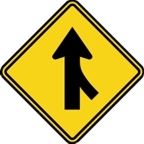
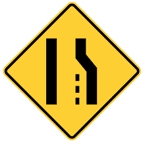
========
MAKE ROOM FOR
ENTERING TRAFFIC
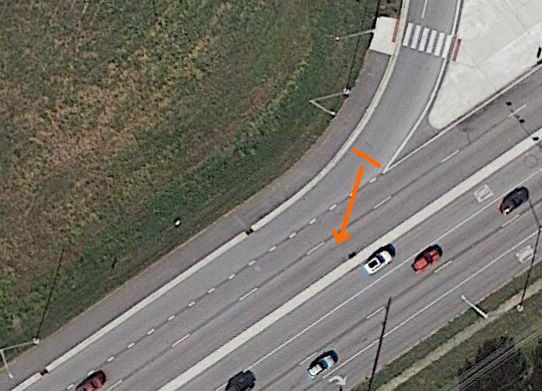
DON'T STOP AT THE
END OF THE RAMP
Many people think the MERGE sign (right) means that drivers should expect that traffic will be joining your stream from the right. But it means much more than this.
The MERGE sign means "MAKE ROOM FOR ENTERING TRAFFIC"
This MERGE sign actually means that drivers in the right lane must make room for entering traffic by adjusting speed or changing lanes so entering vehicles can fit safely into the lane. The entering vehicles do NOT have a YIELD sign. They have the right-of-way because their lane is ending.
The MERGE entrance is much safer than the YIELD entrance because the driver in the right lane of the freeway can see entering traffic much better than the entering driver can see traffic on the freeway:
- Entering drivers must look over their shoulders, instead of where they are going, while the lane is ending.
- Drivers on the freeway have more actions to choose from (adjust speed or change lanes), and will not lose the lane.
So the merging burden is placed on the driver on the freeway.
Be sure to make room for entering traffic. It's your duty. To make room, don't pass or go alongside any other car.
DON'T STOP AT THE END OF THE RAMPUnless there is a STOP or YIELD sign or there is no acceleration lane, don't stop at the end of the ramp:
- Entering drivers who stop are too often hit by the car behind.
- Continue into the acceleration lane. Make lane changes after the end of the ramp.
Too many drivers wait at the end of the ramp until they can immediately cross into the
lane they want (orange line and arrow).
This is quite dangerous.
Some drivers do this because they have never learned how to properly change lanes and merge.

STOP!
(Legally a
STOP sign)
Many people seem to think that when a traffic signal is not lit (e.g. during a power failure) that traffic on the main street does not have to stop. This is not true.
When the signal you are supposed to obey is not showing any lit indication, it legally becomes a STOP sign. You must stop and wait for a time when no traffic is a hazard to your intended movement.
If a traffic signal is not operating properly, stop!
There are several cases:
- One color of light is out on your side. The rest of the signal is operating normally. You must determine which color is out and drive appropriately.
- Some signal faces are out while others are still working. This is usually the result of a traffic accident damaging the signal. Again, do not proceed until the way is clear.
- All of the signals are out. This is usually the result of a power failure. Treat the intersection as an ALL WAY STOP.
- Multiple colors are lit in all signal faces. This usually indicates that the signal controller is damaged. Stop, and do not proceed until the way is clear.
- Some signal faces are missing because they have been knocked down in a crash. Stop, and do not proceed until the way is clear.
If a traffic signal is not operating properly, stop!

YIELD ON
FLASHING
YELLOW
ARROW
Some people think a flashing yellow arrow gives them the right-of-way. This was once true in some states, but it is not true now.
A flashing yellow arrow always means YIELD.
Turning traffic at a flashing yellow signal must always yield to pedestrians and oncoming
traffic.
This is true for both a flashing circular yellow and a flashing yellow arrow.
The purpose of the flashing yellow arrow is not better driver understanding. It is used to eliminate the yellow trap hazard.
Some people think the flashing yellow arrow is the same as a circular green.
- For traffic turning in the direction of the arrow, the flashing yellow arrow has the same meaning the circular green has.
- For traffic not making that turn, the flashing yellow arrow has no meaning at all. Drivers must obey other signal faces.
The flashing yellow arrow signal face controls only one traffic movement. The circular green controls many movements.
A flashing yellow arrow always means YIELD.
If you are turning left at a flashing yellow arrow signal, you must NOT obey the circular signals.

STOP AND
STAY
Some people think a red arrow allows a turn on red. It does not.
The Uniform Vehicle code says a steady red arrow always means stop and stay for any traffic intending to turn in the direction of the arrow.
A flashing red arrow allows a turn in the direction of the arrow after a stop.
A steady red arrow always means stop and stay.
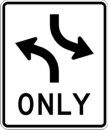
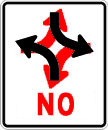
TWO LEFTS! - - - NOT FOUR!
There are two cases where a vehicle using the two-way left-turn lane to merge can block left turns or cause an accident:
- A car moving in the same direction as the entering car wants to go also occupies the
two-way left-turn lane at the same time.
A sideswipe accident could result. - A car moving in the opposite direction as the entering car wants to go also occupies
two-way left-turn lane at the same time.
A head-on accident could result.
In both cases the entering driver is making an unexpected maneuver.
This can cause accidents when drivers try to use the lane for its intended
purpose.
This is an abuse of the two-way left turn lane.
Do not stop in a two-way left-turn lane to merge.
Wait until both ways are clear before entering the intersection!
In most states, the law is: Never enter the intersection unless the way is completely clear to leave it.

DON'T PASS
Passing is prohibited on the circular road of a roundabout for a reason. The lead vehicle
could intend to continue circulating or take the next exit.
Passing can block the other driver from making the maneuver he intends. The vehicle
in front must complete its maneuver before the vehicle behind gets there.
You should signal a right turn when your exit from the roundabout is next.
Many drivers do not do this. They make other drivers wait when they could enter the
roundabout.
Be in the correct lane before entering the roundabout. Posted signs indicate the correct lane.
Never pass other vehicles within a roundabout.
Never change lanes within a roundabout.
Signal a right turn when your exit from the roundabout is next.
HOW TO SIGNAL A ROUNDABOUT RIGHT EXIT
- If your exit is the first one (to the right), signal a right before entering the roundabout.
- While you are rounding the center island, steer with your right hand.
- When your exit becomes the next exit, signal a right, moving the lever with your left hand.
- Take the exit. Steer mainly with your right hand.
- If the turn signal does not cancel after the exit, cancel it manually with your left hand.
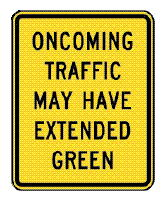
WATCH FOR
YELLOW TRAP
Many states have a law saying that a driver must not enter an intersection unless he knows he can immediately leave it.
There is a reason such a law exists:
There is a danger called "yellow trap".
Yellow trap happens when the following conditions happen at the same time:
- Left turns are allowed to filter through gaps in oncoming traffic when the light is circular green.
- The circular green light facing one direction of traffic changes to yellow while the signal facing the oncoming traffic remains green.
When this happens, left-turning drivers may think oncoming traffic has a yellow and
will stop.
They might turn across live traffic, causing accidents.
Governments are required to post this sign (right) if this can happen, but they rarely
do so.
Often the governments are unaware that yellow trap is occurring because they check
the signals in daytime when traffic is heavier.
Never enter the intersection unless the way is completely clear to leave it.
Never wait in an intersection to turn left. You can be trapped there by oncoming traffic.
This is dangerous, because the other driver signaling the turn may not see you. He might turn anyway.
This is selfish, because the other vehicle is going slow to line up a gap in your lane, not to go slow.
